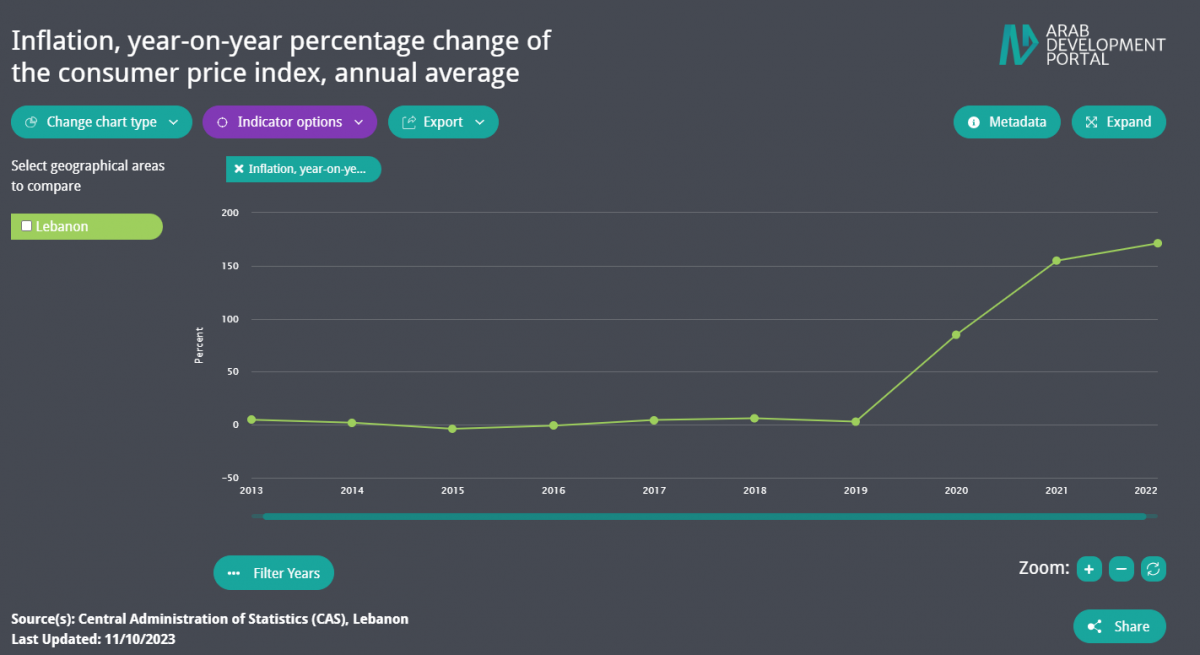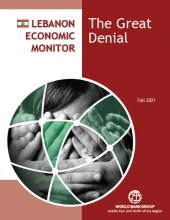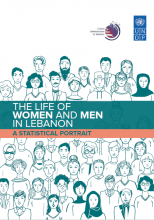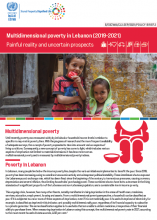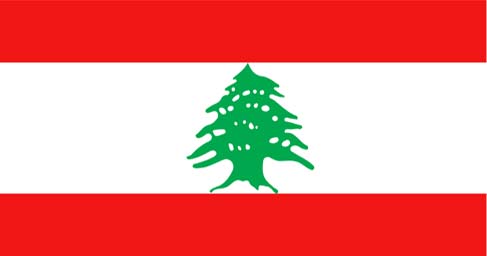 Lebanon
Lebanon
Lebanon is a relatively small country with an estimated population of 5.5 million,[1] and a low fertility rate of 2.08 birth per woman in 2022.[1] Lebanon hosts around 1.5 million Syrian refugees, of which 814,715 registered Syrian refugees [3], in addition to 557,342 Palestinian refugees in 2022.[4]
Since the second half of 2019, an unprecedented and complex economic and financial crisis hit the country, followed by COVID-19 and the explosion at the Port of Beirut on August 4, 2020. The crisis took a severe and heavy toll on the fiscal and external balances and a very high social cost. The Lebanese Pound, pegged since 1993 at 1500 L.L for every USD, witnessed a significant depreciation in its market value reaching as high as 148000 LBP/USD in the black market in 2023.[5] While the Lebanese Pound was still officially fixed, the Lebanese government based the estimations of its latest Financial Recovery Plan, released on 30 April 2020, at a rate of 3500 LBP/USD, publicly expressing its intentions to devaluate the Pound and to move to a more flexible exchange rate by adopting a gradual depreciation of the currency at 5 percent per annum to reach 4,297 LBP/$ in 2024.[6] However, the exchange rate didn’t stabilize registering during the second half of 2023 89,000 LBP/USD in the black market.
The country is suffering from a significant and protracted economic depression, Lebanon’s economic and financial crisis ranks among the worst economic crises globally since the mid-nineteenth century. Nominal GDP plummeted from nearly US$52 billion in 2019 to an estimated US$23.1 billion in 2021. The protracted economic contraction has led to a marked decline in disposable income. GDP per capita dropped by 36.5% between 2019 and 2021, and Lebanon was reclassified by the World Bank as a lower-middle-income country, down from upper-middle-income status in July 2022.[7]
According to the Central Administration of Statistics, the Consumer Price Index increased by 147.6 percent in January 2021 compared to January 2020, registering its seventh consecutive triple-digit increase since July 2020. The annual inflation rate increased from 2.9 percent in 2019 to 84.9 percent in 2020 then to 154.8 percent and 171.2 percent in 2021 and 2022 consequently[8]
Lebanon is officially seeking IMF aid to restructure its public debt and contain its twin deficits (a budget and balance of payments deficits). Lebanon’s debt-to-GDP ratio was estimated at 172.2 percent in 2019 which then registered 349.8 percent in 2021 and decreased to 283.2 in 2022.[12] The Recovery Plan aimed to rein in public debt, down to 99.2 percent in 2024, following the adoption of a series of reforms, among which is restructuring the public debt. Additionally, the government planned to restructure the Central Bank and the banking sector to close the gap in their balance sheets.[6]
Current account deficit was estimated at -27.9 percent of GDP in 2019 which dropped to -17.2 percent in 2021 and increased to -28.8 in 2022.[12]
To achieve fiscal consolidation, the government planned to take measures to reduce expenditures and enhance revenues, as expressed in its Plan. In addition to the reduction in debt service as a result of a foreseeable restructuring, the reduction in expenditures includes limiting the budgetary transfers made to the Electricité du Liban (EDL) and lowering the wage bill by halting recruitment and revisiting employees’ benefits packages, in addition to lowering capital expenditures from 6 percent in 2019 to 2 percent of total expenditures in the 2020 budget. On the other hand, revenue-enhancing measures include improving the collection of taxes and increasing VAT, which stood at 11 percent.[9] In 2019, the wage bill absorbed 39 percent of total expenditure, while transfers to EDL and interest payments amounted to 10 percent, and 32 percent of total expenditures, respectively.[10]
In addition to IMF aid and advisory assistance, Lebanon continues to strive to access the financial commitments made under CEDRE – the Conference for Economic Development and Reform through Enterprises – especially with regard to infrastructure investment. Government formation and fiscal reforms are needed to unlock CEDRE financing of USD 10.2 billion in loans and USD 860 million in grants.[9]
The banking sector informally adopted strict measures and capital controls, distinguishing between pre‐October 2019 dollar deposits (“lollars”) that suffered from a haircut of around 70 percent and the new inflows of “fresh dollars.” The cease of lending has been an additional burden hardly affecting young entrepreneurs and SMEs.[7]
The burden of the economic and financial crisis fell hardest on the lives of Lebanon’s most vulnerable groups. Latest World Bank estimates show that more than half of the country’s population is likely already below the poverty line.[7], whereas the Government’s Recovery Plan estimated national poverty at 48 percent. In addition, the unemployment rate registered it highest value at 29.6 in 2022. [8]
The health system is quite developed despite its flaws, however, the 4th of August Beirut blast caused massive damages to 3 private and 1 public hospital and to 23 Primary Health Care centers. [13] The Government has been trying to introduce reforms to achieve universal coverage.[14] Life expectancy is high at 74.4 years compared to the regional average of 70.8 years[1][2], while maternal mortality and infant mortality are low scoring 21 per 100,000 and 7.1 per 1,000 respectively in 2021.[2] However, positive health attainment is also the result of personal spending by the Lebanese, where general government expenditures on health were estimated at 2.6 percent of the GDP in 2020, and out-of-pocket health expenditures amounted to 44.2% of the current health expenditures.[11]
This overview was last updated in November 2023. Priority is given to the latest available official data published by national statistical offices and/or public institutions.
Sources:
[1] United Nations, Department of Economic and Social Affairs, Population Division. 2023. World Population Prospects. [ONLINE] Available at: https://population.un.org/wpp/ [Accessed 23 October 2023].
[2] The World Bank. 2023. World Development Indicators. [ONLINE] Available at: https://databank.worldbank.org/source/world-development-indicators [Accessed 23 August 2023].
[3] United Nations High Commissioner for Refugees (UNHCR). 2023. UNHCR Data. [ONLINE] Available at: https://www.unhcr.org/what-we-do/reports-and-publications/unhcr-data [Accessed 15 October 2023].
[4] UNRWA. 2023. UNRWA statistics bulletin. [ONLINE] Available at: https://www.unrwa.org/what-we-do/unrwa-statistics-bulletin [Accessed 15 October 2023].
[5] United Nations Development Programme (UNDP). March 2021. March Economic Watch
[6] Lebanon. Ministry of Finance.2020. Lebanese Government Financial Recovery Plan. [ONLINE] Available at: http://finance.gov.lb/en-us/EventPdfs/English/The%20Lebanese%20Government's%20Financial%20Recovery%20Plan.pdf[Accessed 13 April 2021]
[7] World Bank. 2023. Lebanon overview. [ONLINE] Available at: https://www.worldbank.org/en/country/lebanon/overview [Accessed 08 November 2023]
[8] Central Administration of Statistics (CAS), Lebanon. 2023. Consumer price index. [ONLINE] Available at: http://www.cas.gov.lb/index.php/latest-news-en/165-inflation-4 [Accessed 08 November 2023].
[9] Council for Development and Reconstruction, Lebanon. April 2018. Government of Lebanon: Vision for stabilization, growth and employment. [ONLINE] Available at: http://www.cdr.gov.lb/study/cedre/CedreGoLVisionMarch15.pdf [Accessed 13 April 2021].
[10] Republic of Lebanon. Ministry of Finance, Institut des Finances Basil Fuleihan. 2019. Citizen Budget Lebanon 2019. [ONLINE] Available at: http://www.finance.gov.lb/en-us/Finance/BI/ABDP/Annual Budget Documents and Process/Citizen Budget 2019en.pdf [Accessed 13 April 2021].
[11] World Health Organization (WHO). Global Health Expenditures Database. 2023. [ONLINE] Available at: https://apps.who.int/nha/database/Select/Indicators/en [Accessed 15 October 2023].
[12] International Monetary Fund. 2023. World Economic Outlook. [ONLINE] Available at: https://www.imf.org/en/Publications/SPROLLs/world-economic-outlook-databases#sort=%40imfdate%20descending [Accessed 24 October 2023].
[13] UNDP. March 2021. Handling Asbestos after the Beirut Blast. [ONLINE] Available at: https://www.lb.undp.org/content/lebanon/en/home/library/asbestos-health-and-safety-requirements.html [Accessed 13 April 2021].
[14] Ministry of Public Health, Lebanon. 2018. Emergency Primary Health Care Restoration Project towards Universal Health Coverage in Collaboration with World Bank. [ONLINE] Available at: https://www.moph.gov.lb/en/Pages/6/779/universal-health-coverage-project-lebanon [Accessed 13 April 2021].
Data Highlights
-
The annual inflation rate increased from 2.9 percent in 2019 to 84.9 percent in 2020 then to 154.8 percent and 171.2 percent in 2021 and 2022 consequently
